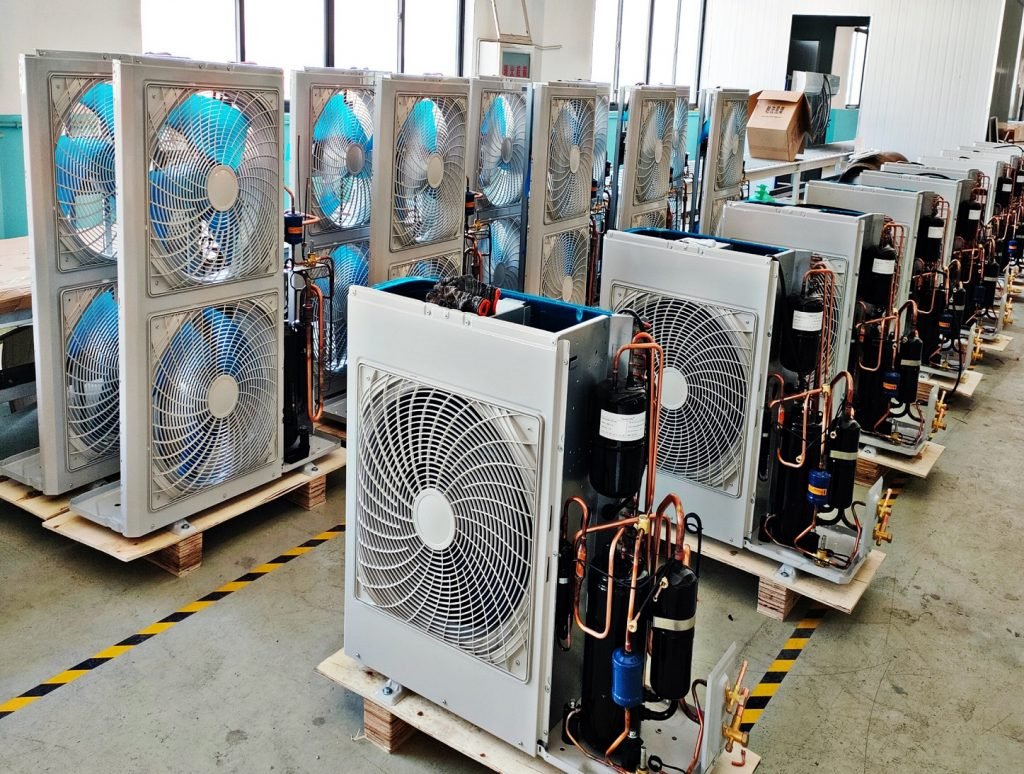Il sistema di refrigerazione è un sistema di ciclo complesso composto da componenti chiave come compressore, condensatore, valvola di espansione, E evaporatore. Questi componenti lavorano insieme per ottenere il raffreddamento attraverso la circolazione del refrigerante.
Tuttavia, Quando l'aria entra in questo sistema chiuso, Può causare problemi di serie che influenzano il suo normale funzionamento. Perciò, è fondamentale capire le cause, distribuzione, pericoli, e metodi di rimozione dell'intrusione dell'aria nei sistemi di refrigerazione.
Cause di aria nel sistema di refrigerazione
Sebbene sistemi di refrigerazione sono cicli sigillati in cui l'aria non deve entrare, L'aria può ancora infiltrarsi per vari motivi.
Di seguito è riportata un'analisi dettagliata di queste cause:
1.Aspirazione incompleta durante l'installazione o la manutenzione
–L'aspirazione è fondamentale per la rimozione dell'aria e dell'umidità durante l'installazione o la manutenzione. Prestazioni scarse per la pompa del vuoto o tempo di aspirazione insufficiente può lasciare aria nel sistema.
–Gli operatori inesperti o i problemi di attrezzatura possono anche comportare un aspirapolvere incompleto.
2. Aria introdotta durante l'aggiunta del refrigerante
–Procedure improprie, come contenitori refrigeranti non sigillati o tubi collegati erroneamente, può consentire all'aria di entrare nel sistema durante refrigerante aggiunta.
–I metodi di riempimento aperti aumentano la probabilità di entrare nell'aria.
3. Perdita di sistema
–I punti di perdita nel sistema possono far entrare l'aria, soprattutto se entrambi gli alti & I lati a bassa pressione hanno perdite. Le differenze di pressione facilitano l'intrusione dell'aria.
–La perdita si verifica spesso ai collegamenti del tubo, SEIL VALVOLE, o sigilli del compressore.
4. Usa refrigeranti scadenti o contenitori non sigillati
–I refrigeranti scadenti possono contenere impurità o umidità, Presentazione dell'aria nel sistema.
–I contenitori scarsamente sigillati consentono all'aria di mescolare refrigeranti e successivamente inserisci il sistema.
5. Mancanza di rimozione dell'aria durante il funzionamento a lungo termine
–Col tempo, L'aria può infiltrarsi lentamente il sistema, soprattutto con significative fluttuazioni della pressione.
–La negligenza dell'operatore o l'attrezzatura per la rimozione dell'aria malfunzionante possono provocare l'accumulo d'aria.
6. Penetrazione dell'aria atmosferica
Se la pressione operativa del sistema è inferiore alla pressione atmosferica, L'aria può penetrare nel sistema attraverso lacune nelle valvole, compressori, o connessioni non saldate.
7. Decomposizione dell'olio lubrificante
Alcuni oli lubrificanti, come oli minerali, può decomporsi in condizioni di lavoro complesse, rilasciando idrocarburi che si mescolano con il refrigerante.
Distribuzione dell'aria nel sistema di refrigerazione
1. Posizioni di accumulo naturale
L'aria è più leggera di refrigeranti e tende ad accumularsi in punti alti del sistema, ad esempio:
Condensatore: Spesso installato in una posizione alta nel sistema, rendendolo un punto di accumulo d'aria comune.
Ricevitore: Un altro punto più alto in cui l'aria si riunisce facilmente.
Accumulatore: Alcuni sistemi vedono l'aria che si accumula qui.
Sezioni alte di tubi: Qualsiasi sezione di tubi elevati può diventare una posizione per l'accumulo d'aria.
2. Movimento dell'aria nel sistema
L'aria può dissolversi nel refrigerante e spostarsi attraverso il sistema durante il funzionamento, influenzare vari componenti.
3. Impatto di progettazione del sistema sulla distribuzione dell'aria
—Layout di tubazioni complesse: Aumenta potenziali aree per l'accumulo d'aria.
—Differenze di altezza: Le grandi variazioni di altezza nel sistema possono portare a aria concentrata in punti più alti.
Pericoli d'aria nel sistema di refrigerazione
1. Aumentare il consumo di energia
L'aria consiste principalmente di azoto e ossigeno, che sono gas non condensabili. L'accumulo d'aria sul lato ad alta pressione aumenta la pressione del sistema, forzare il compressore lavorare di più, Aumenta il consumo e l'usura dell'energia, e abbreviare la vita del compressore.
2. Indurre reazioni chimiche
L'umidità nell'aria può reagire refrigeranti, soprattutto nei sistemi ad olio minerale, producendo sostanze acide che corrodono i componenti metallici interni, portando a perdite e danni.
3. Ridurre l'efficienza di raffreddamento
L'aria nel condensatore o nell'evaporatore può causare “chiuse d'aria,” ostruire il flusso del refrigerante e lo scambio di calore, ridurre l’efficienza complessiva del sistema.
4. Forma un blocco di ghiaccio
L'umidità nell'aria potrebbe congelarsi sui dispositivi di strozzamento (per esempio., valvole di espansione), causando blocchi che disturbano refrigerante flusso e può danneggiare l'apparecchiatura.
5. Compromettere le prestazioni della valvola di espansione
La presenza di aria può distorcere le letture della pressione sulla valvola di espansione, portare a una regolazione inadeguata e a un flusso di refrigerante instabile.
6. Problemi di lubrificazione del compressore
L'umidità nell'aria può degradarsi olio lubrificante, ridurne l’efficacia e la causa compressore usura o guasto.
Metodi per rimuovere l'aria dal sistema di refrigerazione
1. Utilizzare meccanismi di rilascio dell'aria progettati dal sistema
Molti sistemi di refrigerazione Avere dispositivi di sfiato automatico, come valvole di sfiato situate nella parte superiore del condensatore. Questi dispositivi possono espellere automaticamente l'aria durante il funzionamento del sistema. Per utilizzare questi dispositivi per lo sfiato:
Individua le valvole di rilascio dell'aria: Spesso sul punto più alto del condensatore.
Rilascio manuale: Aprire lentamente la valvola durante il funzionamento per rilasciare aria durante il monitoraggio dei manometri per evitare refrigerante perdita.
2. Metodo di estrazione del vuoto
Utilizzare la pompa a vuoto per evacuare il sistema può rimuovere efficacemente l'aria e l'umidità.
Preparare la pompa a vuoto: Seleziona una pompa a vuoto adatto alla capacità del sistema e assicurati che sia in buone condizioni di lavoro.
Collegare la pompa del vuoto: Collegare la pompa del vuoto alla porta del vuoto del sistema.
Processo di evacuazione: Avviare la pompa del vuoto e continuare l'evacuazione fino a quando la pressione del sistema non raggiunge il livello di vuoto specificato. Di solito è necessario mantenere questo livello per un po 'per garantire una rimozione completa di aria e umidità.
Controlla il livello del vuoto: Utilizzare un manometro per monitorare il livello del vuoto e assicurarsi che soddisfi i requisiti tecnici.
3. Rilascio di aria manuale
Quando il sistema è in uno stato di spegnimento, Aprire manualmente la valvola di sfiato per rilasciare aria.
Individua la valvola di sfiato: Identifica la valvola di sfiato nel sistema, normalmente situato nel punto più alto.
Aprire lentamente la valvola: Apri gradualmente la valvola di sfiato per rilasciare aria. Monitorare il flusso del refrigerante per evitare una significativa perdita del refrigerante.
Ripetere lo sfiato: Ha fatto più operazioni di sfiato fino a quando non sono comparse bolle.
4. Rilascio d'aria ad alta temperatura
Aumentando il sistema temperatura, l'umidità nell'aria evapora, e poi l'aria viene espulsa.
Riscaldare il sistema: Utilizzare apparecchiature di riscaldamento per aumentare la temperatura del sistema, facendo evaporare l'umidità.
Sfiatare l'aria: In condizioni di temperatura elevata, espellere l'aria e il vapore acqueo attraverso la valvola di sfiato.
Raffreddare il sistema: Dopo che il sistema si è raffreddato, controllare l'eventuale presenza di aria rimanente.
5. Usa gli essiccanti
Aggiungere essiccanti al sistema per assorbire l'umidità e ridurre l'impatto dell'aria.
Seleziona l'essiccante: Utilizzare essiccanti adatti al tipo di refrigerante, come i setacci molecolari.
Installare l'asciugatrice: Installa un asciugatrice nel sistema e sostituire regolarmente l'essiccante.
6. Misure preventive
Controllare regolarmente la presenza di perdite: Ispezionare periodicamente la tenuta del sistema per impedire l'ingresso di aria.
Aggiungere correttamente il refrigerante: Quando si aggiunge refrigerante, assicurarsi che il contenitore sia sigillato per evitare la miscelazione dell'aria.
Mantenere l'integrità della tenuta: Durante la manutenzione e l'installazione, Assicurarsi che tutte le connessioni siano adeguatamente sigillate.
7. Precauzioni di sicurezza e ambientali
Indossare marcia protettiva: Durante le operazioni di sfiato, Indossare guanti e occhiali protettivi per prevenire le ustioni fredde del refrigerante.
Prevenire le perdite del refrigerante: Aderire alle normative ambientali per prevenire perdite di refrigerante che potrebbero danneggiare l'ambiente.
Usa strumenti professionali: Garantire l'uso di strumenti e attrezzature appropriate per le operazioni di sfiato.
8. Verificare l'efficacia di sfiato
Test di pressione: Monitorare la pressione del sistema utilizzando un manometro per garantire la stabilità.
Osservare lo stato operativo: Dopo il funzionamento del sistema, Osservare l'effetto di raffreddamento e le prestazioni del compressore per garantire anomalie.
9. Problemi comuni
Sistema ancora non raffreddando: Ciò può indicare aria residua o altri guasti, Richiedere ri-avvenzione o ulteriore risoluzione dei problemi.
Anomalie della pressione: Controllare eventuali perdite del sistema o guasti all'essiccante.
Conclusione
Ingresso d'aria sistemi di refrigerazione è una questione significativa che non può essere ignorata, poiché non solo influisce sull’efficienza del sistema ma può anche ridurre la durata delle apparecchiature. Durante l'installazione può entrare aria nel sistema, manutenzione, perdite, o carica di refrigerante, accumulandosi principalmente in aree alte come condensatori o vicino valvole di espansione. Ciò porta ad una riduzione dell’efficienza, danni al compressore, blocchi, e squilibri di pressione.
Per risolvere questo problema, questo articolo introduce vari metodi per rimuovere l'aria, compreso l’utilizzo delle valvole di sfiato del sistema, ventilazione manuale, scarico del vuoto, ventilazione ad alta temperatura, e utilizzando essiccanti per assorbire l'umidità. Inoltre, misure preventive come controlli regolari delle perdite, corretta carica del refrigerante, e il mantenimento della tenuta del sistema sono cruciali.
In sintesi, rimuovere tempestivamente l'aria dal sistema è essenziale per mantenere un funzionamento efficiente e prolungare la durata dell'apparecchiatura. Mentre sono disponibili più metodi per la rimozione dell'aria, la prevenzione rimane fondamentale. Attraverso una manutenzione regolare e pratiche di installazione adeguate, può garantire il buon funzionamento del sistema.
Per gli operatori di sistema, la vigilanza contro l'ingresso di aria e l'adozione di misure adeguate sono fondamentali per garantire il funzionamento stabile a lungo termine dei sistemi di refrigerazione. Questi metodi e misure preventive non solo migliorano l’efficienza ma fanno anche risparmiare sui costi di manutenzione a lungo termine.
Eventuali commenti?
Benvenuto, lascia un messaggio o ripubblicalo.













